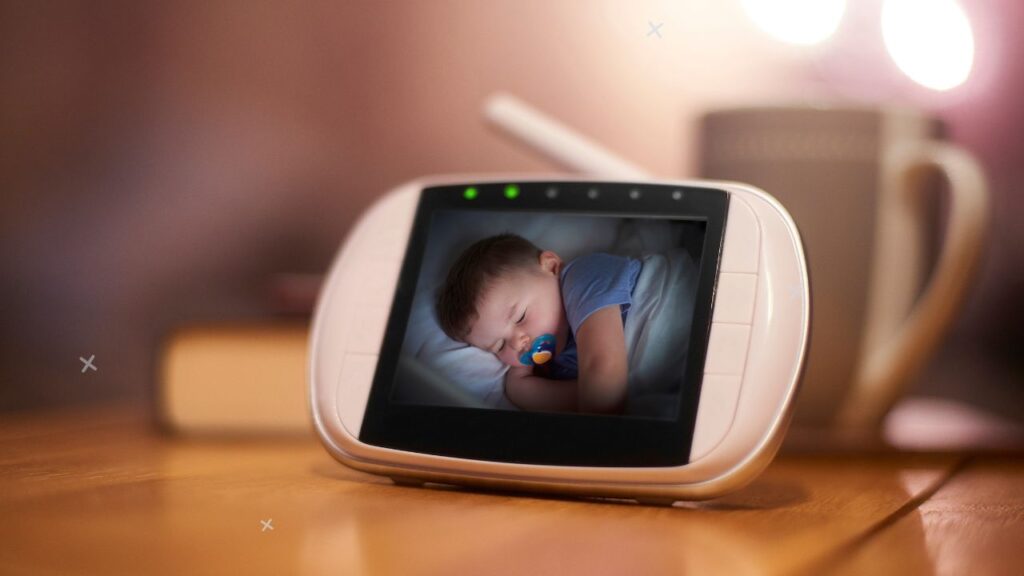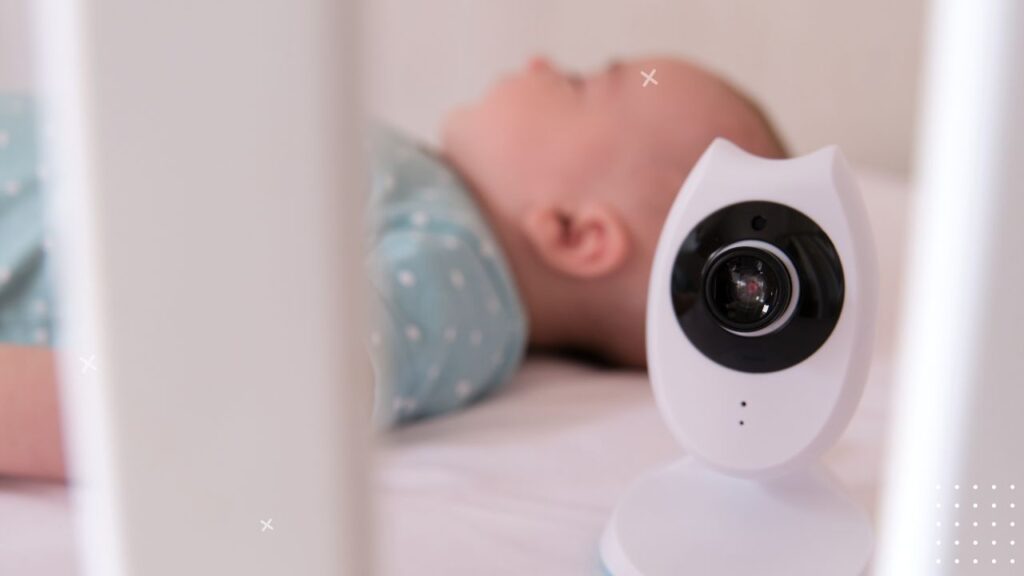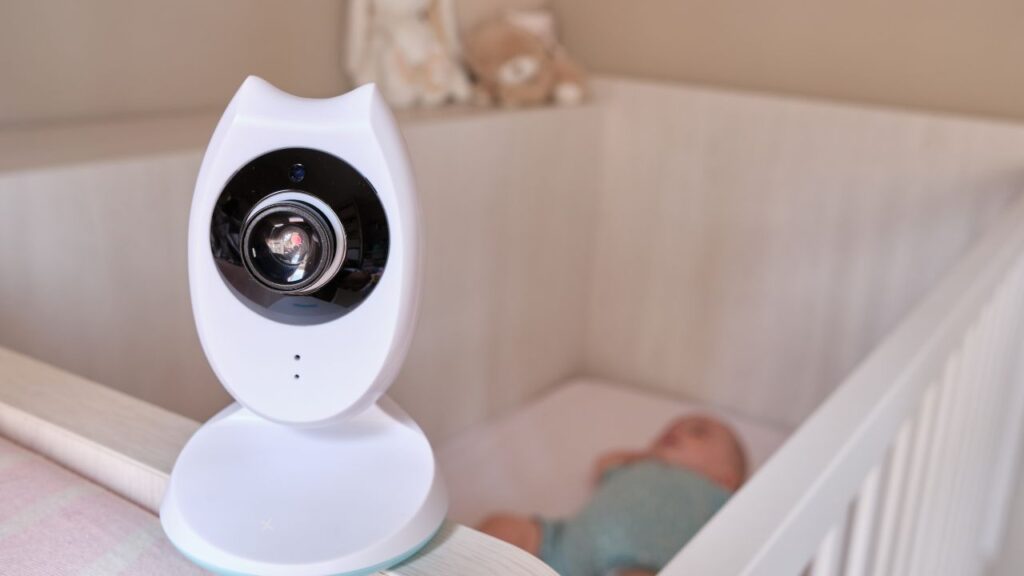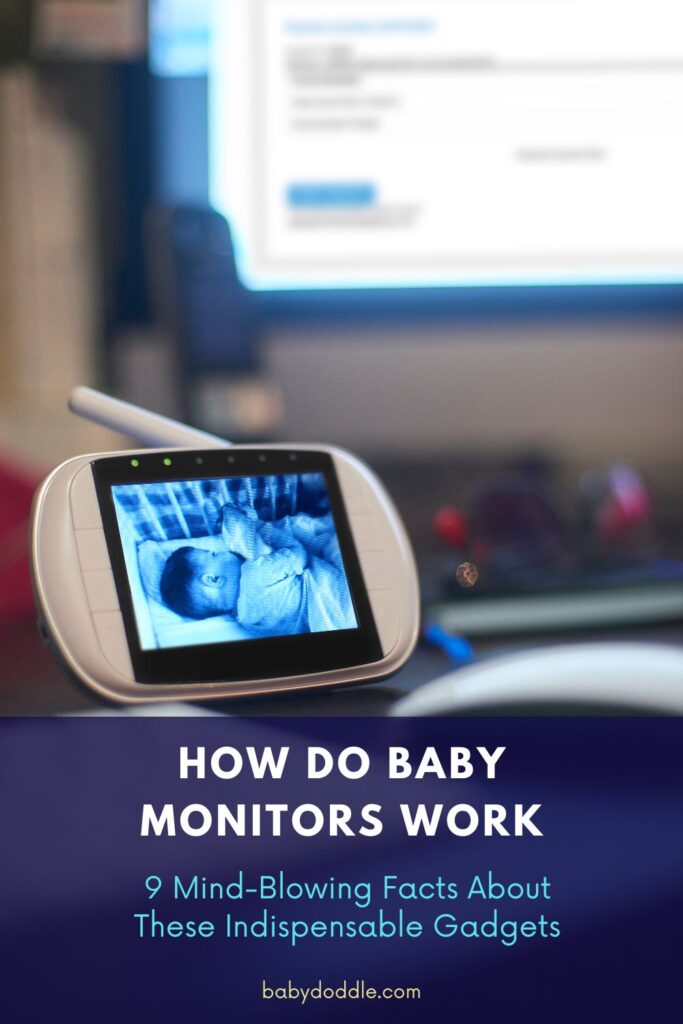Picture this: You’re finally getting some much-needed rest after a long day with your little one. Suddenly, you hear a soft coo coming from the device on your nightstand. It’s your baby monitor, letting you know your bundle of joy is awake. But have you ever wondered how these magical devices actually work? Well, get ready to have your mind blown! We’re about to dive into the fascinating world of baby monitors and uncover 9 incredible facts about these indispensable gadgets.
The Evolution of Baby Monitors: From Simple to High-Tech
Let’s take a quick trip down memory lane. Baby monitors have come a long way since their humble beginnings in the 1930s. Back then, they were simple radio devices that picked up baby sounds. Fast forward to today, and we’ve got gadgets that would make James Bond jealous!
The journey of baby monitors is like watching a caterpillar transform into a butterfly. They’ve morphed from basic audio devices to high-tech marvels that can do everything but change diapers (though I’m sure someone’s working on that!). We’ve seen the rise of video monitors, digital technology, and even Wi-Fi-connected smart monitors that can send alerts to your smartphone.
Here’s a quick breakdown of the types of baby monitors available today:
- Audio/Analog Monitors: The OG of baby monitors. They transmit sound only.
- Video/Digital Monitors: These let you see and hear your baby.
- Wi-Fi-based Monitors: Connect to your home network for extended range.
- Smartphone Monitors: Turn your phone into a baby monitor with an app.
Next time you’re shopping for a baby monitor, think about how far we’ve come. It’s pretty amazing!

How Do Baby Monitors Work: The Basic Principle
Now, let’s get into the nitty-gritty of how baby monitors work. At their core, all baby monitors operate on a simple principle: they have a transmitter unit (in the baby’s room) and a receiver unit (with you). It’s like having a tiny radio station in your nursery!
The transmitter unit is always “listening” for sounds. When it picks up a noise – whether it’s a cry, a coo, or just your baby rolling over – it sends that information to the receiver unit. The receiver then plays the sound for you to hear. It’s like having super-powered ears that can reach across your whole house!
Different types of baby monitors use different signals to transmit this information:
- Analog monitors use radio waves, similar to old cordless phones.
- Digital monitors use encrypted signals for better security.
- Wi-Fi monitors connect to your home network and can send information to your smartphone or tablet.
Think of it like this: if your baby’s sounds were a letter, the transmitter would be the envelope, and the type of monitor would determine whether it’s sent by regular mail, express post, or email!
Mind-Blowing Fact #1: Two-Way Communication
Here’s where things start to get really cool. Many modern baby monitors don’t just let you listen to your baby – they let you talk back too! This feature, known as two-way communication, is like having a walkie-talkie with your little one.
How does it work? Well, the parent unit (that’s the one you keep with you) has a microphone. When you speak into it, your voice is transmitted back to the baby unit in the nursery. It’s then played through a speaker, allowing your baby to hear you.
This feature is a game-changer for parents. Imagine being able to soothe your baby with your voice without having to get out of bed in the middle of the night. You can sing a lullaby, shush them gently, or just let them know you’re there. It’s like having a superpower that lets you be in two places at once!
Next time you’re using your baby monitor, try out the two-way talk feature. It might just save you a trip to the nursery!
Mind-Blowing Fact #2: Video Monitoring
If two-way audio wasn’t impressive enough, let’s talk about video baby monitors. These devices don’t just let you hear your baby – they let you see them too! It’s like having a tiny TV channel dedicated to your little star.
Video baby monitors work by adding a camera to the transmitter unit in the baby’s room. This camera captures images and sends them to the receiver unit, which has a screen for you to watch. Some even use infrared technology for night vision, so you can see your baby clearly even when it’s dark. It’s like having Superman’s x-ray vision, but for checking on your sleeping beauty!
Here’s a quick comparison of different types of video monitors:
| Type | Pros | Cons |
|---|---|---|
| Digital | Good image quality, Secure | Limited range |
| Wi-Fi | Long range, Smartphone compatible | Relies on internet connection |
| Smartphone | Convenient, Uses existing devices | Depends on app quality and phone battery |
Next time you’re peeking at your baby through a video monitor, take a moment to appreciate the technology that’s letting you do it. It’s pretty incredible when you think about it!
Mind-Blowing Fact #3: Motion and Sound Detection
Hold onto your hats, because this next fact is a real doozy. Many modern baby monitors don’t just passively transmit sounds and images – they actively monitor for specific events. It’s like having a tiny, tireless babysitter watching over your little one.
These monitors use advanced sensor technology to detect motion and sound. When they pick up on something – say, your baby stirring in their sleep or starting to cry – they can alert you right away. Some can even distinguish between background noise and your baby’s cries, so you’re not constantly jumping at every little sound.
Here’s how it works:
- Motion sensors in the camera detect any movement in the crib.
- Sound sensors pick up on noises above a certain volume threshold.
- The monitor’s processor analyzes this data in real-time.
- If it detects significant motion or sound, it sends an alert to the parent unit or your smartphone.
It’s like having a super-smart guard dog that never sleeps and never barks unless it’s really important!
Next time your monitor alerts you, take a moment to appreciate the complex technology working hard to keep your baby safe. It’s pretty amazing stuff!

Mind-Blowing Fact #4: Temperature and Humidity Monitoring
As if watching and listening to your baby wasn’t enough, many baby monitors now come with built-in thermometers and hygrometers. That’s right – they can tell you the temperature and humidity in your baby’s room! It’s like having a tiny weather station in the nursery.
Why is this important? Well, maintaining the right temperature and humidity can help your baby sleep more comfortably and reduce the risk of SIDS. Most experts recommend keeping the nursery between 68-72°F (20-22°C) with a humidity level of 30-50%.
Here’s how these monitors measure room conditions:
- Temperature sensors detect the ambient temperature in the room.
- Hygrometers measure the amount of moisture in the air.
- This data is processed and displayed on the parent unit or your smartphone.
- Some monitors can even send alerts if the temperature or humidity goes outside the ideal range.
It’s like having a guardian angel watching over your baby’s comfort!
Next time you check your baby monitor, take a look at the temperature and humidity readings. It’s a simple way to ensure your little one is sleeping in a comfortable environment.
Mind-Blowing Fact #5: Breathing and Heart Rate Monitoring
Now, here’s where baby monitors start to feel like something out of a sci-fi movie. Some advanced monitors can actually track your baby’s breathing and heart rate! It’s like having a mini hospital monitor right in your nursery.
These monitors usually come in the form of wearable devices – like special socks or bands that your baby wears. They use sensors to detect tiny movements in your baby’s chest or changes in blood flow that indicate breathing and heartbeats.
Here’s a basic breakdown of how it works:
- Sensors in the wearable device detect subtle movements or changes in blood flow.
- This data is processed and analyzed in real-time.
- The information is transmitted to the parent unit or your smartphone.
- If any irregularities are detected, the monitor sends an alert.
It’s important to note that while these monitors can provide peace of mind, they’re not medical devices and shouldn’t replace regular check-ups or safe sleep practices.
Next time you’re considering a baby monitor, think about whether this level of monitoring would help you feel more at ease. It’s pretty incredible what technology can do these days!
Mind-Blowing Fact #6: Smart Home Integration
Just when you thought baby monitors couldn’t get any smarter, they go and integrate with your entire smart home system! It’s like your whole house is working together to help you take care of your baby.
Many modern baby monitors can connect to other smart devices in your home. This means you can:
- View your baby monitor feed on your smart TV
- Ask your smart speaker to play white noise in the nursery
- Have your smart lights turn on automatically when the monitor detects movement
It’s like having a team of high-tech helpers all working together to make your parenting life easier!
Here’s a quick look at some popular smart home integrations:
| Smart Device | Integration with Baby Monitor |
|---|---|
| Smart TV | Display video feed |
| Smart Speaker | Play lullabies, white noise |
| Smart Lights | Turn on when movement detected |
| Smart Thermostat | Adjust room temperature based on monitor readings |
Next time you’re setting up your baby monitor, consider how it might work with other smart devices in your home. You might be surprised at how much easier it can make your life!
Mind-Blowing Fact #7: Mobile App Connectivity
In this age of smartphones, it’s no surprise that baby monitors have gone mobile. Many modern monitors can connect directly to your smartphone or tablet through a dedicated app. It’s like having a baby monitor in your pocket at all times!
These apps do more than just show you a video feed. They can:
- Send push notifications when your baby makes noise or moves
- Let you adjust monitor settings remotely
- Store and share cute video clips or photos
- Track your baby’s sleep patterns over time
It’s like having a baby command center right on your phone!
Here’s a tip: When choosing a Wi-Fi baby monitor with app connectivity, look for one with strong security features to protect your family’s privacy. And remember, while these apps are super convenient, they shouldn’t replace actually checking on your baby in person regularly.
Next time you’re out on a date night, take a moment to marvel at the fact that you can check on your baby from anywhere with an internet connection. Technology is pretty amazing, isn’t it?
Mind-Blowing Fact #8: Data Encryption and Security
Now, let’s talk about something really important – keeping all that baby data safe and secure. With all the information modern baby monitors are collecting and transmitting, it’s crucial that they have strong security measures in place. It’s like having a tiny Fort Knox in your nursery!
Digital and Wi-Fi baby monitors use various methods to protect your data:
- Encryption: This scrambles the data so that even if someone intercepts it, they can’t understand it.
- Frequency hopping: This constantly changes the frequency the monitor uses, making it harder to hack.
- Secure Wi-Fi protocols: These protect the data as it travels over your home network.
It’s like having a secret code that only you and your baby monitor know!
When choosing a baby monitor, look for ones that advertise strong security features. And always make sure to change the default password on any Wi-Fi connected device.
Next time you’re using your baby monitor, take comfort in knowing that all those ones and zeros flying through the air are keeping your baby’s privacy safe and sound.
Mind-Blowing Fact #9: AI and Machine Learning in Baby Monitors
Hold onto your diapers, because this last fact is a real game-changer. Some of the newest baby monitors are using artificial intelligence (AI) and machine learning to become even smarter. It’s like having a tiny robot nanny watching over your little one!
These AI-powered monitors can:
- Learn your baby’s sleep patterns and predict when they’re likely to wake up
- Distinguish between different types of cries (hunger, discomfort, etc.)
- Detect if your baby has rolled over onto their stomach
- Analyze your baby’s sleep quality over time
It’s like having a baby expert on call 24/7!
Here’s a quick look at some potential future developments in baby monitor technology:
- Emotion recognition: Monitors that can tell if your baby is happy, sad, or frustrated
- Health monitoring: Devices that can detect early signs of illness
- Development tracking: Monitors that can track your baby’s developmental milestones
Next time you’re using your baby monitor, imagine what it might be able to do in a few years’ time. The future of baby care is looking pretty exciting!

Choosing the Right Baby Monitor: What to Consider
With all these amazing features available, how do you choose the right baby monitor for your family? It’s like being a kid in a candy store – so many options, but you can’t have them all!
Here are some factors to consider:
- Your home layout: Do you need a long-range monitor or will a short-range one suffice?
- Your tech comfort level: Are you okay with a Wi-Fi connected device, or would you prefer a simpler model?
- Your budget: More features generally mean a higher price tag
- Your monitoring needs: Do you want audio only, or is video a must-have?
Remember, the best monitor is the one that gives you peace of mind and helps you get some sleep!
Here’s a quick comparison of some special types of monitors:
| Type | Pros | Cons |
|---|---|---|
| Dual-camera | Can monitor two rooms at once | More expensive |
| Long-distance | Works over greater distances | May have less reliable connection |
| Wearable | Tracks vital signs | May cause false alarms |
Next time you’re baby monitor shopping, think about what features are most important to you. And don’t be afraid to ask for demonstrations or read lots of reviews before making your choice!
Setting Up Your Baby Monitor
So you’ve chosen your baby monitor – now what? Setting it up might seem daunting, but don’t worry! It’s usually pretty straightforward. Here’s a general guide:
- Choose a good spot: Place the camera where it has a clear view of your baby, but out of reach.
- Connect the power: Plug in both the camera and parent unit (if it’s not battery-operated).
- Pair the devices: Follow the manufacturer’s instructions to connect the camera and parent unit.
- Test it out: Make sure you can hear and/or see clearly from different parts of your home.
- Secure it: If it’s a Wi-Fi monitor, change the default password to something strong and unique.
Remember, every monitor is a bit different, so always refer to your specific model’s instructions.
Here’s a pro tip: Do a “walk test” around your home to check the monitor’s range. You don’t want to find out it doesn’t reach your living room when you’re trying to relax during naptime!
Why You Need a Baby Monitor
At this point, you might be thinking, “Do I really need all this high-tech gear just to watch my baby sleep?” Well, let me tell you, a good baby monitor can be a real lifesaver!
Here are some reasons why baby monitors are so great:
- Peace of mind: You can rest easy knowing you’ll hear if your baby needs you.
- Better sleep for everyone: You don’t have to constantly check on your baby in person.
- Freedom to move: You can do things around the house while your baby naps.
- Early warning: You can respond quickly if your baby is uncomfortable or in distress.
- Tracking sleep patterns: Many monitors help you understand your baby’s sleep habits.
It’s like having an extra set of eyes and ears dedicated to your baby’s wellbeing!
Remember, a baby monitor is a tool to help you, not replace you. It’s still important to physically check on your baby regularly.
Next time you’re debating whether you really need a baby monitor, think about all the ways it could make your life easier. Sometimes, a little peace of mind is priceless!
Conclusion
Whew! We’ve covered a lot of ground, haven’t we? From the basic principles of how baby monitors work to the mind-blowing advancements in AI and machine learning, it’s clear that these little devices are pretty incredible.
Let’s recap our 9 mind-blowing facts:
- Two-way communication lets you talk to your baby
- Video monitoring gives you eyes in the nursery
- Motion and sound detection alerts you to important events
- Temperature and humidity monitoring ensures a comfy sleep environment
- Breathing and heart rate monitoring offers next-level peace of mind
- Smart home integration makes your whole house baby-friendly
- Mobile app connectivity puts monitor control in your pocket
- Data encryption keeps your baby’s information safe
- AI and machine learning are making monitors smarter than ever
As we look to the future, who knows what amazing features baby monitors might have next? One thing’s for sure – they’ll keep working hard to help parents get some much-needed rest!
Remember, no matter how high-tech your baby monitor is, nothing beats the love and attention of a caring parent. These gadgets are here to help you, not replace you. So go ahead, embrace the technology, but don’t forget to trust your instincts too.
Now, if you’ll excuse me, I think I hear a baby crying through my monitor. It’s time to put all this knowledge into practice!
FAQ – How do baby monitors works ?
How do I choose the best baby monitor for my needs?
Frequently Asked Questions
How do I choose the best baby monitor for my needs?
Choosing the best baby monitor depends on your specific needs and preferences. Consider these factors:
- Range: If you have a large home, look for a monitor with a long range.
- Audio vs. Video: Decide if you want to just hear or also see your baby.
- Portability: If you travel often, a compact, battery-operated monitor might be best.
- Additional Features: Consider if you want extras like temperature monitoring or two-way talk.
- Budget: Prices vary widely, so determine what you’re comfortable spending.
- Security: For Wi-Fi monitors, ensure it has strong encryption to protect your privacy.
- Reliability: Read reviews to check for issues like interference or false alarms.
Remember, the “best” monitor is the one that gives you peace of mind and fits your lifestyle. Don’t be swayed by fancy features you won’t use. Instead, focus on what’s most important for your family’s needs.
Are baby monitors safe to use?
When used correctly, baby monitors are generally safe. However, there are a few safety considerations to keep in mind:
- Cord Safety: Keep all cords at least 3 feet away from the crib to prevent strangulation risks.
- Placement: Mount cameras securely out of baby’s reach.
- Radiation: While the low-level electromagnetic fields (EMF) from baby monitors are considered safe, you can minimize exposure by placing the monitor at least 6 feet from your baby.
- Security: For Wi-Fi monitors, use strong passwords and keep firmware updated to prevent hacking.
- Dependence: Don’t rely solely on the monitor. Regular in-person checks are still important.
- Wearables: If using a wearable monitor, follow size and placement guidelines carefully.
Always follow the manufacturer’s safety instructions and guidelines. If you have specific health concerns, consult with your pediatrician.
How far do baby monitors typically work?
The range of baby monitors can vary significantly depending on the type and model:
- Analog Monitors: Usually have a range of 600-900 feet in open areas.
- Digital Monitors: Can reach up to 1,000 feet in open areas.
- Wi-Fi Monitors: Can work anywhere you have an internet connection.
However, these are “open field” ranges. In reality, walls, floors, and other obstacles can significantly reduce the effective range. Most monitors work well within a typical home, but you might experience issues in very large houses or outdoors.
To maximize range:
- Keep the monitor away from other electronic devices to minimize interference.
- Try to maintain a clear line of sight between the baby unit and parent unit.
- For Wi-Fi monitors, ensure a strong Wi-Fi signal throughout your home.
Always test the monitor’s range in different areas of your home before relying on it.
How do I troubleshoot common baby monitor issues?
Here are some common issues and their potential solutions:
- Static or Interference:
- Move the monitor away from other electronic devices.
- Try changing the channel (if your monitor has this feature).
- Check for and remove potential sources of interference (like Wi-Fi routers or cordless phones).
- Short Battery Life:
- Ensure you’re fully charging the battery.
- Reduce screen brightness on video monitors.
- Consider replacing the battery if it’s old.
- Poor Video Quality:
- Clean the camera lens.
- Adjust the camera angle or distance from your baby.
- Check your Wi-Fi connection for Wi-Fi monitors.
- Connection Issues:
- Ensure both units are powered on.
- Check if you’re within the monitor’s range.
- For Wi-Fi monitors, restart your router and check your internet connection.
- False Alarms:
- Adjust the sensitivity settings if your monitor has this option.
- Ensure the monitor isn’t picking up noise from outside the baby’s room.
If problems persist, consult your monitor’s manual or contact the manufacturer’s customer support.
Can baby monitors be hacked?
While it’s relatively rare, some baby monitors, particularly Wi-Fi-connected models, can potentially be hacked. Here’s what you need to know:
- Risk Factors:
- Using default passwords
- Outdated firmware
- Unsecured Wi-Fi networks
- Cheaper monitors with poor security features
- Prevention:
- Always change default passwords to strong, unique ones.
- Regularly update your monitor’s firmware.
- Use a secure, password-protected Wi-Fi network.
- Turn off remote access features when not needed.
- Choose monitors from reputable brands with good security track records.
- Signs of Hacking:
- Camera moves on its own (for PTZ cameras)
- Unfamiliar voices coming from the monitor
- Login attempts from unknown IP addresses
- What to Do If You Suspect Hacking:
- Immediately unplug the monitor
- Change all related passwords
- Update firmware
- Report the incident to the manufacturer
Remember, non-Wi-Fi digital monitors are much harder to hack than Wi-Fi-connected ones. If security is your top concern, consider opting for one of these models.
By following good security practices, you can significantly reduce the risk of your baby monitor being hacked and enjoy the convenience and peace of mind these devices offer.












